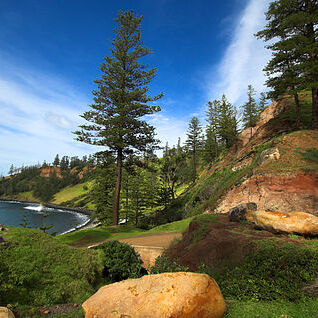Tree to 70 m high with trunk to 2 m diam. Bark peeling in thin flakes. Branches horizontal; ultimate shoots horizontal or somewhat pendulous; shoots, including leaves, 7–10 mm diam. Juvenile leaves subulate, 1–1.25 cm long, incurved, transitional to mature leaves. Mature leaves in imbricate series encircling stems, broadly ovate, 4–7 mm long, 3–6 mm wide, minutely ciliolate, with slightly incurved, blunt, horny apex. Male cones solitary, 4–5 cm long, 1–1.3 cm diam. Female cones subglobose, 7.5–10 cm long, 8–10 cm diam.; scales 3.5–4 cm long, upper half with wings 7–10 mm wide, and an upturned, soft, apical spine 5–8 mm long. Seeds 2.5–3 cm long, 1.3–1.5 cm wide.
Large tree; bark dark grey-brown, peeling in thin flakes, deep pink beneath. Semi-juvenile lvs (on lowest branches of mature trees) somewhat flattened, 3-11 mm long, linear-subulate, acute, incurved. Adult lvs (from coning branches) ± flattened, 5-9 mm long, ovate or ovate-elliptic, ± obtuse, slightly keeled, strongly imbricate, incurved. ♂ strobili 3-5 cm long, narrow-cylindric. ♀ cones towards top of tree, 9-13 cm diam., broadly oblong-ellipsoid or subglobose, green at maturity; emergent part of scale (prickle) 6-10 mm long and c. 2 mm wide at 1/2 way to apex, pungent, directed forward.
An upright tree. It has a regular branching pattern. It grows to 30-70 m high and spreads 6-20 m across. The trunk can be 2 m wide. The bark peels in thin flakes. The branches are in rings of 4-7. The leaves are sickle shaped. They are 8-15 mm long by 1-2 mm wide. They are shorter on fertile branches. The leaves are crowded. They have an in-curved sharp point. The cones are 10 cm long and 12 cm wide.


